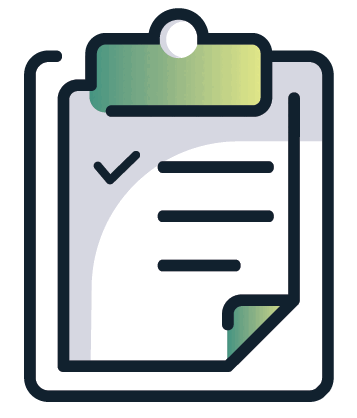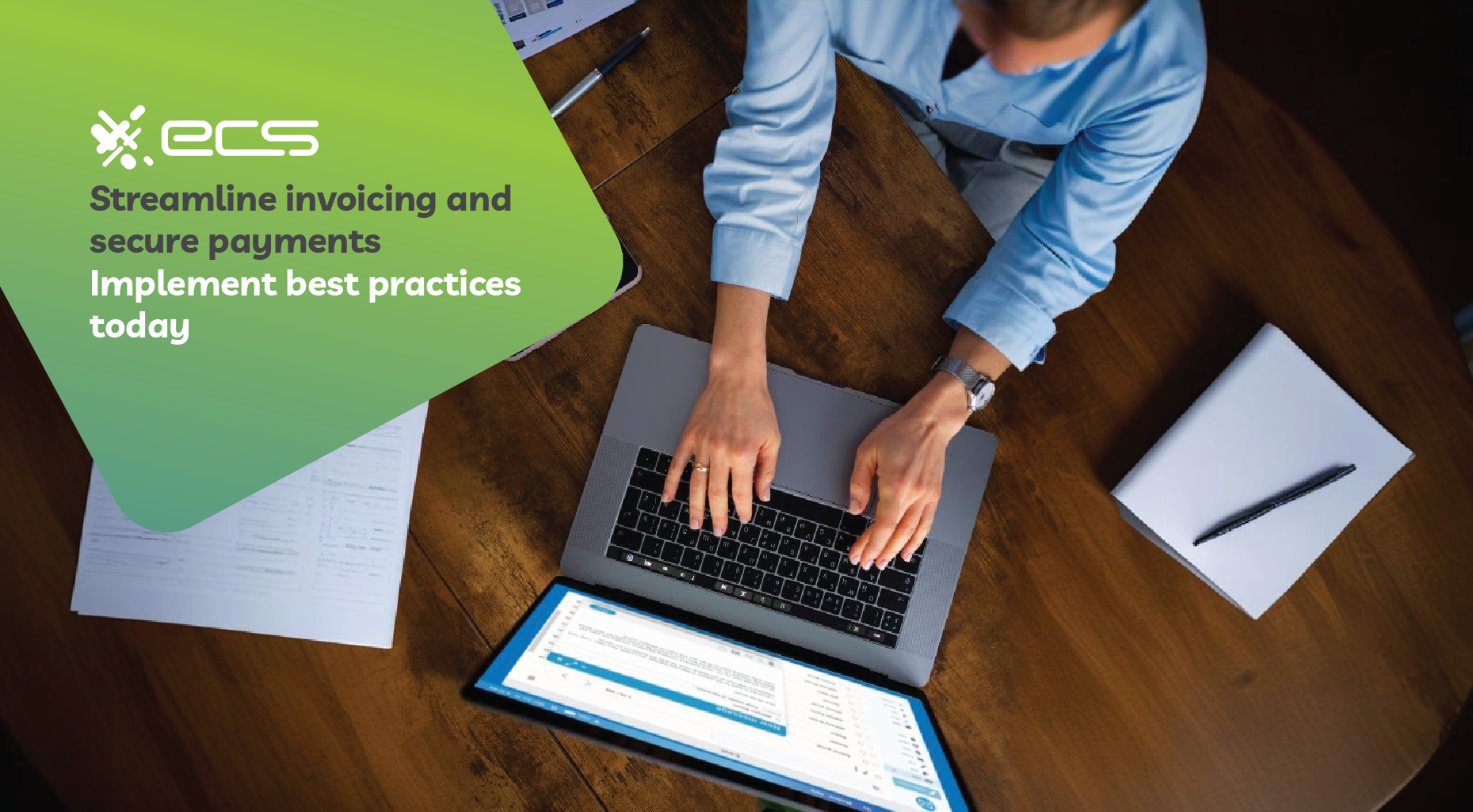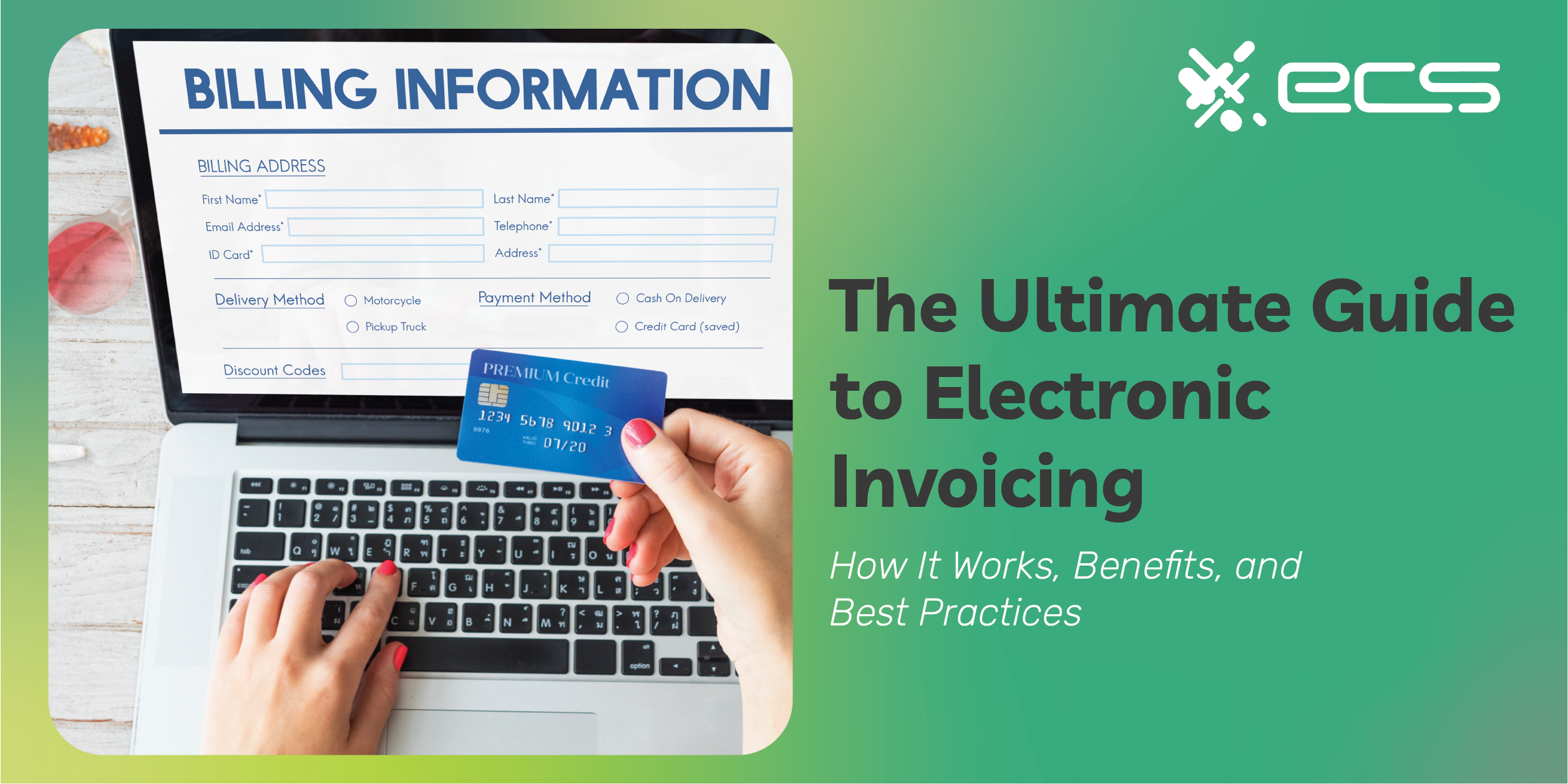Accounts payable is the lifeblood of your business. For many small businesses, manual invoice processing has been the norm for decades. But a digital transformation is taking place across the landscape of business processes…and that includes the accounts payable process. An electronic, automated system for collecting timely payments will improve efficiency and reduce the risk of bad debt. We’re talking about the benefits of electronic invoicing.
What is Electronic Invoicing?
Electronic invoicing or digital invoicing is the practice of sending an invoice via email or providing a clickable link to an invoicing platform. E-invoicing for businesses contrasts traditional paper invoicing, where customers are sent a paper invoice or bill.
The e-invoice process is straightforward: you can send customers or clients an invoice embedded in an email or as an attachment (PDF). You can also email or text them a link to an invoicing platform. Either way, there is a button they can click on to make a payment via credit card, debit card, or ACH transfer.
In some cases, your presentation of the invoice may allow the customer to enroll in a payment plan. In many ways, receiving an electronic invoice is much like shopping online. All you need to do to pay is input your card info and click!
From the customer’s perspective, e-invoicing is much easier than traditional paper-based invoicing. There’s no need to mail a check, pick up the phone, or even type in a website. In fact, with mobile integrations, paying could be as simple as scanning a credit card or opening up a mobile wallet. From your perspective, electronic invoicing will save you all the costs of mailing paper invoices. You’ll also increase your likelihood of getting paid on time.
You might be wondering if there are different types of electronic invoicing software. In broad terms, there are two different types, and they parallel the two different approaches to business software: on-premise and cloud-based. On-premise software is stored and managed at your business’s site: on a server or installed on your computer.
Cloud-based business services, invoicing included, are “located” somewhere else (namely, the servers of the software company). A data “cloud” allows business owners like yourself to access the services anywhere, from any device—provided they can log in. Cloud-based software is usually a subscription model, where the customer (in this case, you) pays a monthly or yearly fee to access the service.
How Does Electronic Invoicing Work?
So, how does e-invoicing implementation work? The particulars will vary from business to business, but we can examine a typical workflow. Within your e-invoicing software, you will have a list of goods or services you offer. To create a new invoice, you will select which goods have been provided or services rendered.
These items will be added to the invoice, including client or customer information (ideally, you will have this information pre-loaded). There should be opportunities to edit the quantity, pricing, and description on the invoice itself. Overall, the process is much easier, automated, and cleaner than crafting paper invoices—mainly handwritten ones.
You will then send the invoice to your buyer. The software will have a send button to deliver the invoice via email or text. For small business owners or freelancers, this is typically all you need. However, larger retailers and those rendering more substantially priced services often need more options.
For wholesalers and suppliers, you will want to offer your buyer flexibility in payment. Net-30, 60, 90, and 2/10 payments may be on the table. Allowing your customer to select their preferred payment terms adds a level of complexity that electronic invoicing is ready to tackle. E-invoicing can make this easy. Because it’s automated, you won’t have to juggle pay dates or send reminders.
If your invoicing is consumer-facing, you won’t use terminology like Net-30. However, you may want the opportunity to offer customers payment plans. Around 16% of American consumers prefer BNPL (buy now, pay later). The trend is remarkably higher with millennials, nearly 40% opting for BNPL at the point of sale.
With paper invoicing, BNPL or installment plans rely on the customer to proactively make payments, leading to missed payments and lost revenue. By contrast, electronic invoicing automates and implements payment plans successfully to completion.
Electronic invoicing works best when it’s integrated with other systems like CRM (customer relationship management), IRM (inventory resource management), or EHR (electronic health records). As customers make purchases or receive services, those software platforms will automatically reflect changes. Of course, you want your invoicing software to integrate with your accounting suite so you don’t have to manually transfer any data.
Benefits of Electronic Invoicing
Electronic invoicing solutions have some immediately recognizable benefits.

Eliminating Manual Work
As just mentioned, invoicing systems integration with other business software eliminates a lot of manual work. How much? One study found the average SMB owner spends 10-15 hours per week on bookkeeping, but some spend up to 25 hours. Are you one of the business owners spending 1,300 annually on accounting (including invoicing)?
Think about the old process of sending a paper invoice, especially with software that doesn’t save information or connect with other software. You have to bounce back and forth between systems (inventory, customer management, health records) as you fill out the invoice. You have to double-check the description, pricing, and quantity. In some industries (particularly healthcare), using the wrong item name (e.g., insurance billing code) can have disastrous consequences.
Generally speaking, the average rate of error in business processes is 1%. Sounds insignificant. But is it, really? Errors are not just about losing money. They frequently require going back to rectify the mistake, which, of course, means more time and money. Invoicing automation tools and the integration provided by cloud-based invoicing eliminate this 1%.

Industry Compliance
Another e-invoice benefit is adhering to industry compliance. Manual paper invoicing makes it easy to run afoul of federal, state, or local regulations. If you use a cloud-based invoicing platform, that company is forced to stay atop the latest regulations, because they are servicing hundreds, thousands, or millions of clients aside from your business. You can outsource the compliance issues and reasonably rely on them to catch them.
For example, does your state require certain taxes or surcharges to be applied to goods and services? Are those passed on to the customer, or can you cover them up with your pricing? Either way, electronic invoicing compliance will factor these laws and regulations into the invoice. According to one study, the average “cost” of business compliance was $5.47 million, while noncompliance costs $14.82 million. Even if your SMB isn’t playing with millions, the implication is that running afoul of the law is 3x more expensive.

Preserving The Environment
Environmental stewardship is another electronic invoicing benefit. Even if it doesn’t matter much to you, 78% of consumers care. Businesses that have traditionally used a lot of customer-facing paper-record keeping (like banks) have played off this sentiment. Many banks allow customers to select a “leaf” logo and opt for paperless statements. Adding such a graphic to signage about digital invoicing and/or including eco-friendly language makes a positive impression on the buyers receiving your invoices.
How Electronic Invoicing Improves Business Operations
Let’s take a deeper dive into how e-invoicing can improve business operations. And let’s start by looking at the enhanced customer engagement it affords. Traditional paper invoicing means sending your buyer a piece of mail. Did you know that 32% of American adults don’t pay their bills on time? 61% of them attributed this lateness to not having money. But that means 39% have to blame it on something else.
There’s a decent chance your buyer will toss your invoice into the “read later” pile and forget about it. Don’t think that things are any different for a business owner. Business owners are, well…busy. With traditional paper invoicing, you cannot control when the buyer will pay their invoice. But with e-invoicing, you can be a little more proactive.
First, paying an e-invoice is much more inviting because it’s easier. With one-click pay, the buyer can immediately take care of the invoice. If they don’t, your invoicing platform can automatically send email (and perhaps even text) reminders. You won’t have to put anything in your planner or remember to call the customer about their invoice.
If you’re anything like most businesses, you’re not just sending one invoice at a time. Can you imagine having to keep track of dozens or hundreds of invoices and when they’ve been paid? Of course, this is how businesses used to take care of billing. But with accounts payable automation, there’s no reason to take on the extra stress of sending reminders.
Cloud-based invoicing software can also help you take real-time track of your invoicing. It will typically have some sort of dashboard that provides some basic stats: how many outstanding invoices you have, cashflow in, cashflow out, and any other relevant KPIs your software provider can add. This “big data” is one of the most exciting aspects of electronic invoicing trends, reflecting a broader analytics landscape.
These analytics could be used to deepen customer relationships. They can tell you, for instance, what percentage of time a specific buyer pays their Net-30 invoice early, or if they are routinely late. This, in turn, might inspire a conversation about Net-60 pricing (more favorable for them) in return for larger orders (more favorable for you).
Common Misconceptions About Electronic Invoicing
SMBs might have reservations about electronic invoicing, let’s take a look at some common misconceptions.
Electronic Invoicing is expensive
The first argument against electronic invoicing is that it is too expensive to implement. This reservation is fairly common across the landscape of business service software. That may have been true in previous times when business software was on-site. However, cloud-based subscription models have imploded that notion and democratized these products and services.
Electronic Invoicing Will Impose High Credit Card Fees
Another misconception is that electronic invoicing will result in high credit card fees. Paper invoicing often facilitates paper payments like mailed checks. Won’t asking a customer to click on a button and make a payment online result in steep credit card fees?
Actually, that concern is merited when working with a company like PayPal, Stripe, or Square. PayPal, for instance, might charge 3.5% to receive payment on an invoice, then charge you again when you deposit the funds into your checking account.
The way around this concern is to avoid using large payment aggregators. Instead, you should work with a smaller payment processor that can provide interchange-plus pricing. This pricing model more accurately reflects the actual expense of running a card through the networks (e.g. visa or mastercard).
Electronic Invoices Are Not Secure
Another concern is that electronic invoices are not secure. This concern is also distant from the truth. In part, SMBs are targeted more than larger business types because hackers know their resources are more limited. Typical “doorways” for hackers to exploit are phishing emails or insecure wireless networks.
Cloud-based software can eliminate many of these issues, particularly when it relies on elements like 2FA or two-factor authentication (e.g. receiving a text to your phone). A cloud provider will also have more robust encryption protocols in place. This means they have scrambled customer data (like stored payment information) so that it’s incomprehensible—much more so than a spreadsheet on your office computer hard drive.
Electronic Invoices Are Difficult to Integrate
Another myth is that invoicing software will be “difficult to integrate with existing systems.” We live in an era of open-source codes and APIs (application programming interfaces). This means that software companies can bridge the “gaps” between each other with just a little bit of coding, creating a seamless world of software-based workflows. Most payment processors you speak to will be able to integrate their invoicing solution with accounting platforms and even industry-specific suites you use.
How to Implement Electronic Invoicing in Your Business
It’s important to consider the needs of your business when selecting your invoicing software. This will inform the presentation of the invoice, payment options, and a potential structure of reminders for the buyer. For instance, a wholesaler must present flexible payment options like Net-30 or 2/10. A healthcare provider must provide insurance billing codes and a description of the services rendered. A mechanic may need to integrate state and local fees and taxes to dispose of hazardous materials.
Every business is different. However, one thing they probably all have in common is the need for a cloud-based solution. As mentioned, this limits the security concerns presented by on-site hardware that has to be serviced and protected. In some rare cases, on-site software will actually make more sense.
Some factors suggest on-site software makes more sense: when a company needs a high level of supervision over the data, a plethora of customizations, quick access to large files, and/or faces strict compliance regulations that require additional layers of security solutions. Banks and healthcare systems are two examples of businesses that may differ from the typical business.
However, by and large, cloud-based is the way to go for most SMBs. When choosing invoicing software, you must ensure it integrates with your payment processor. A good place to start your search is to ask your current payment processor if they do invoicing. You must also bring up any other software you use, such as accounting and ERP systems.
Once the invoicing software is ready to go and integrations with other platforms are in place, you must train your employees how to use it. Most software companies will provide instructions on using the software or at least some tutorials. If you have a larger enterprise, ask if a customer success rep or account manager can train your employees in person. Also, make sure to gauge how available the customer service is. Large companies like Square and Stripe have notoriously slow and unhelpful customer service.
Best Practices for Maximizing the Benefits of Electronic Invoicing
While in-person training and accessible support are helpful, some of the best e-invoicing practices are on you to implement. As mentioned, phishing emails are one typical Trojan Horse to sacking the Troy of your business. Let’s say a customer calls in because they forgot the password to access your online, customer-facing platform. They want to pay their bill today. Is it really a customer? Security protocols must be put in place to deal with these situations.
If you are storing customer payment information for long-term relationships or implementing payment plans, you must adhere to PCI DSS (payment card industry data security standards). These are rules set forth by Mastercard and Visa about how to securely store card information.
The invoicing software company can carry many of these rules and regulations. However, some of them will fall on you. Employees should have unique login credentials. They should not be “upcycled” to new hires as old ones leave. You should not send invoices or access the accounting suite on public WiFi, like a coffee shop. If you have wireless hardware on-site (like a router), you must avoid using the preset passwords they come with.
Security is an interesting topic in and of itself. But let’s talk about some other vital best practices. One is crafting a system of reminders. If you can give buyers the option to receive emails and/or text messages, you can automate text reminders about upcoming payments. This will prevent missed payments. If payments are automated, it will create an added layer of transparency and proactivity that the buyer will appreciate.
In some industries and with some clients, you will have to fight a little bit of an uphill battle to implement e-invoicing. Some business owners have been using paper invoices for decades and will be stuck in their ways. One strategy is to continue sending paper invoices that direct the client to make a credit card payment on a website. This directive can be accompanied by phrasing on the invoice that celebrates how easy it is to pay online. You can also offer incentives like early payment discounts via e-billing.

Future Trends in Electronic Invoicing
What does the future of electronic invoicing look like? AI, machine learning, biometrics, and crypto are just a few of the tech developments that will change the landscape of accounts receivable. They will improve the ease and increase efficiency of the invoicing process and create new e-invoicing security needs.
Imagine sending an invoice that a customer can pay with a thumbprint or retinal scan. Apple, Visa, Mastercard, and Amazon are just a few Fortune 500 companies that have already rolled out biometric payment plans. For example, Apple allows customers to unlock mobile wallets with a thumbprint or facial scan. Amazon has also implemented palm-scanning payment terminals at its own stores and at Whole Foods.
Cryptocurrency is another rising payment method that invoicing will need to accommodate. One appeal of crypto is its decentralized nature transcends international boundaries, avoiding currency exchange rates and fees. Businesses conducting international commerce in both B2B and B2C contexts may want to give their customers the ability to settle an invoice with Bitcoin, Ethereum, or any other particular coinage. Global e-invoices can address these challenges.
An increased preference for electronic record-keeping may also accelerate digital invoicing. For instance, the IRS has recently tightened the sails (if that metaphor fits) on reporting thresholds for 1099 work. Although the $600 limit has existed since 2021, and pushback delayed the rollout in 2023, it will be unavoidably enforced for 2024 returns.
In conjunction with America’s premier tax authority adding 78,000 agents to its roster, this hotly contested reporting threshold indicates a trend toward increased accountability which can only be achieved through electronic record keeping. Paper invoices may go the way of the past as federal and state regulations demand increased accountability from SMBs and even independent contractors.
Conclusion
Electronic invoicing is a great way to reduce costs and hours of human capital investment while also eliminating business risks like interruptions to your cash flow. Unfortunately, the approval process for invoicing software is not smooth sailing for every business. New businesses, businesses with credit incidents, and “high-risk” industries need to find an amiable software provider.
In general, SMBs, even those in “regular” industries, will do better with a fintech company that can give them the time of day…not large aggregators like Square or PayPal. To learn more about what ECS can do for you, let’s get in touch and discuss your current invoicing process.
Frequently Asked Questions About Electronic Invoicing
Businesses use electronic invoicing (e-invoicing) to send invoices for money due to customers via email or text instead of traditional paper invoices– allowing businesses to issue and receive payments online for a faster, secure, and more convenient process.
A business will send an electronic invoice as an email or text link or attachment (like a PDF). The customer can view, click a button, and pay the invoice online with their credit card, debit card, or ACH transfer.
Electronic invoicing has many benefits including:
– improved efficiency
– reduced errors
– decreased costs
– enhanced cash flow
– more on-time payments
– environmental sustainability
– better integration with accounting and CRM systems
Electronic invoicing software should include security features such as encryption and two-factor authentication to protect sensitive customer data.
Electronic invoicing can benefit businesses of all sizes, including small, medium, and large enterprises. If your business is service based, rather than storefront retail, e-invoicing could be a great option for you.
